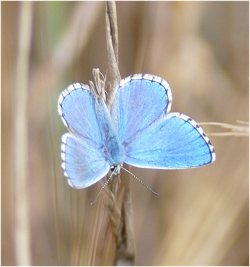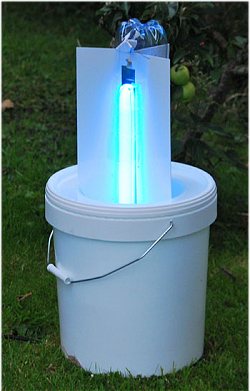General Information about Butterflies and Moths
Life Cycle of Butterflies and Moths
Butterflies and moths go through four distinct stages in their life cycle - egg, caterpillar, chrysalis and butterfly/moth. Most butterflies take a year to complete this life cycle whilst others may produce two or three generations between spring and autumn.
Eggs are laid on or underneath the food plants relevant to that particular species. When the caterpillar emerges it will then feast on its host plant. Caterpillars are tiny when they first emerge but grow rapidly and shed their skin several times before they pupate into a chrysalis. Some species of moth caterpillar will eat the flowers, fruits or roots of its food plant, as well as the leaves.
The chrysalis is well camouflaged to protect them from predators, resembling leaves or bird droppings - except for those that are protected by ants in their nests. The caterpillar of some moth species can take years to develop but most only take a few weeks.
Once the adult butterfly/moth emerges from the chrysalis it must warm up and inflate its wings, its body temperature must reach 32 degrees C. The male's main purpose in life is to mate with as many females as possible, and the female's is to mate soon after emerging from the chrysalis and then avoid males and find places to lay her eggs. Some male moths will mate before the female has even dried her wings, some will locate where the female cocoons are and simply wait for them to emerge. Female moths emit pheromones which male moths detect through their antennae. In some species, such as the Belted Beauty, the female moth has no wings at all and does not move far from her pupa case. Moths can live for a few days to a few weeks, unless they hibernate through winter. They feed on nectar, the same as butterflies, but some short-lived moths do not feed at all.
The life-cycles of moths are carefully synchronised with those of their food-plants, so that the caterpillars hatch when food is in plentiful supply. Birds rely on caterpillars as food for their young, so time their breeding to coincide with the moths' life-cycles.
Difference between Moths and Butterflies
Moths and butterflies are of the taxonomic order Lepidoptera. Around 2500 species of moth have been recorded in the British Isles. The main difference between the two is that british butterflies have clubbed antennae - moths have many varieties of antennae. None , except for burnet moths, have clubbed antennae (burnet moths can be distinguished from butterflies because they have slender wings which they hold close to their bodies, butterflies do not).
Migration
Some species of butterfly and moth fly thousands of miles, e.g. Red Admiral, Painted Lady, Clouded Yellow butterflies and Hummingbird Hawk and Silver Y moths which appear every year in Britain from southern Europe and Africa.
Butterfly Families
Hesperiidae : Skippers - Small and lively with broad hairy bodies and a large gap between the base of the two antennae.
Papilionidae: Swallowtails - large with wing tails. Only one species in the UK.
Pieridae: Whites and yellows
Lycaenidae: Coppers, hairstreaks and blues - around a third of the world's butterfly species belong to this group. Small, flighty butterflies with a metallic sheen to their wings. Many are cared for by ants when they are caterpillars.
Riodinidae: Metalmarks - only the Duke of Burgundy in this family resides in the UK.
Nymphalidae: Brush- or four-footed - these butterflies walk on their back two pairs of legs only, the front pair being vestigial. Family included emperors, admirals, bvanessids, fritillaries, browns and the Monarch.
Moth Families
These are more complex than the butterfly families. Briefly, they consist of the following:
Hepialidae - Swift moths
Zygaenidae - Forester and burnet moths
Limacocidae
Castniidae
Sesiida - Clearwings
Lasiocampidae - Eggar moths
Saturniidae - Emperor moths
Drepanidae - Hook-tips
Geometridae - Mochas, waves, carpets, pugs, thorns, beauties, umbers
Thyatiridae
Sphingidae - Hawkmoths
Notodontidae - Prominent and kitten moths
Lymantriidae - Tussock moths
Arctiidae - Footman, tigers, ermines
Noctuidae - Darts, underwings and clays, brocades, quakers, leaf-eating wainscots, sharks, shoulder-knots, chestnuts, swallows, daggers, beauties, arches, brindles, minors, rustics, silver and gold Y's, brasses, Clifden nonpareil, snouts and fanfoots
Protection of Butterflies and Moths
Wildlife and Countryside Act 1981 Section 5 of The Wildlife and Countryside Act 1981 deals with the protection of British butterflies and moths. It is illegal to catch, handle or harm the following species (eggs, caterpillar, chrysalis, adults). It is also illegal to net them even if you let them go unharmed. The only exception applies to individuals who have been granted a special licence to handle these species for conservation purposes. Trading in these species is also illegal, whether they are live creatures or dead specimen pinned for display. Unfortunately the law does not protect these butterflies if they are captive-bred.

Butterflies :-
Heath Fritillary (melitaea athalia)
High Brown Fritillary (argynnis adippe)
Large Blue (glaucopsyche arion)
Large Copper (lycaena aurinia)
Marsh Fritillary (euphydryas aurinia)
Swallowtail (papilo machaon)
Moths :-
Barberry Carpet (pareulype berberata)
Black-veined (siona lineata)
Essex Emerald (thetidia smaragdaria)
Fiery Clearwing (bembecia chrysidiformis)
Fisher's Estuarine (gortyna borelii)
New Forest Burnet (zygaena viciae)
Reddish Buff (acosmetia caliginosa)
Sussex Emerald (thalera fimbrialis)
UK Biodiversity Action Plan (BAP)
In response to the Convention on Biodiversity, held in Rio de Janeiro in 1992, the UK was the first country to publish its Biodiversity Action Plan. The Plan details action to protect our most threatened species and habitats from further decline or extinction. The butterflies and moths currently identified by the UK BAP as in dire need of protection are listed at the Joint Nature Conservation Committee website.
Notes on trapping Moths
 The Moth Trap is set up towards dusk and is left in a sheltered part of the garden overnight. You will have packed a number of egg boxes into the bottom of the tub so that when moths drop into it, they have places to hide.
The Moth Trap is set up towards dusk and is left in a sheltered part of the garden overnight. You will have packed a number of egg boxes into the bottom of the tub so that when moths drop into it, they have places to hide.
In the morning, you go out armed with a camera and some small plastic containers to "catch" each moth in.
Once the Moth Trap light has been switched off and removed, you will see many moths in, on and around the egg boxes in the tub. If it is a warm day, they may all want to fly out the moment you disturb the tub ..... so we cover the top of the tub with a large piece of cardboard the moment the light has been removed.
When the card is lifted, one egg box is SLOWLY and CAREFULLY lifted out, and the cardboard "lid" is quickly put back again. One person holds the egg box while the other attempts to ease each moth into one of the see-through plastic containers.
Once all the moths from that egg box are "trapped" in the plastic containers, then each one is tipped out onto a surface, one at a time, and quickly photographed....then the moth is released, unhurt. Photographing them enables you to have a record of the moth so that it can be identified later, using a moth book. In this way, each moth is kept in captivity for as short a time as possible.
Moth trap information and photo courtesy of Lorraine Harrison.
This article was originally published on the web on butterflyplants.co.uk however that website is defunct at May 2015. The copyright is with the original owners of butterflyplants.co.uk.

